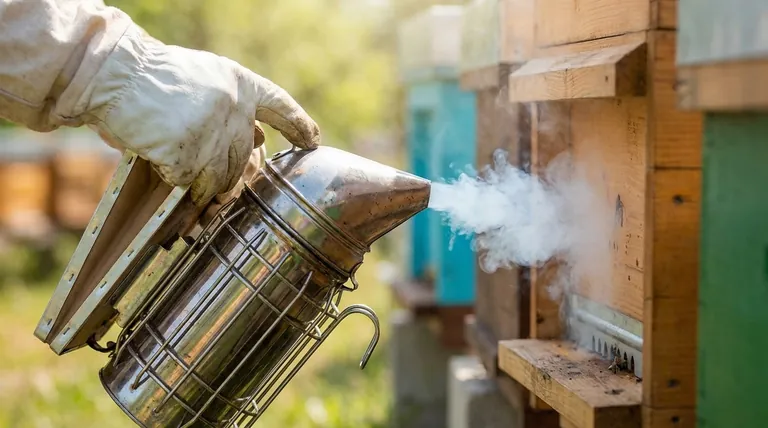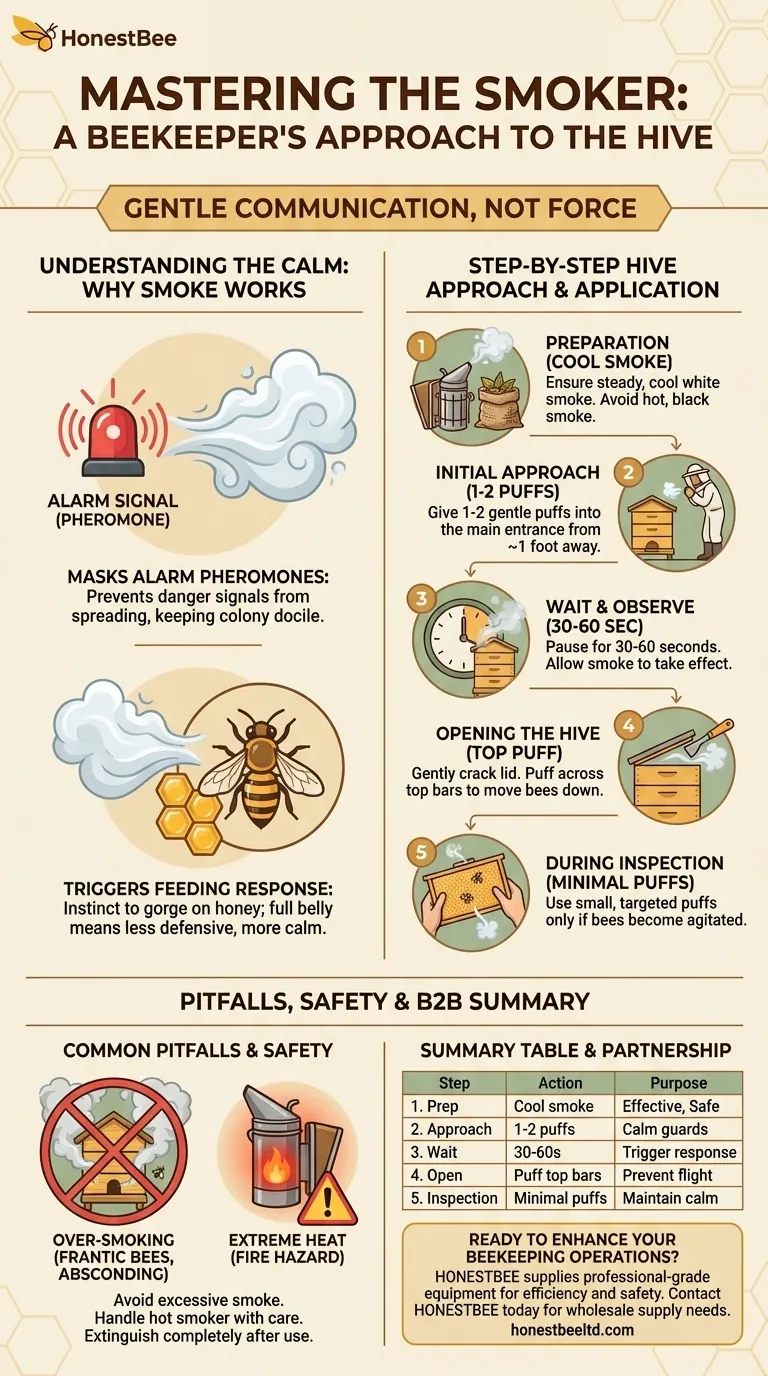Using a bee smoker correctly is a foundational skill for any beekeeper, focused on gentle communication rather than force. To approach the hive, give one to two calm puffs of smoke into the entrance from about a foot away. Wait 30-60 seconds before gently cracking the lid and puffing a small amount of smoke across the top bars, then proceed with your inspection.
The core principle is not to flood the hive with smoke, but to use just enough to interrupt the bees' alarm signals. It is a tool for finesse that makes the bees calmer and the beekeeper safer, transforming a potentially defensive encounter into a manageable inspection.

Understanding How Smoke Calms a Hive
To use a smoker effectively, you must first understand why it works. The smoke is not a blunt instrument; it leverages the bees' natural instincts in two specific ways.
Masking the Alarm Signal
When a hive perceives a threat, guard bees release an alarm pheromone. This chemical signal instantly puts the entire colony on high alert, increasing the likelihood of stings.
Cool, white smoke effectively masks these pheromones, preventing the alarm from spreading. By interrupting their primary channel for communicating danger, you keep the colony in a calmer, more docile state.
Triggering a Feeding Response
The smell of smoke also triggers a primal survival instinct related to forest fires. The bees' immediate response is to prepare for a potential evacuation of their home.
To do this, they rush to the honey cells and begin gorging on honey, loading up on resources. A bee with a full belly is physically less able to curl its abdomen to sting and is generally more preoccupied and docile.
The Step-by-Step Approach to the Hive
A successful hive inspection begins before you even touch the hive. A calm and methodical approach is key.
Before You Approach
First, ensure your smoker is lit correctly and producing a steady stream of cool, white smoke, not hot, black smoke. Use a natural fuel like untreated burlap, pine needles, or cotton.
The Initial Application
Approach the hive from the side or rear, avoiding the bees' direct flight path at the entrance. Give one or two gentle puffs into the main entrance. This calms the guard bees, who are the first line of defense.
Wait and Observe
Do not immediately open the hive. Wait 30-60 seconds to allow the smoke to permeate the lower section of the hive and for the bees to begin reacting to it.
Opening the Hive
Use your hive tool to gently pry open the outer cover, then the inner cover. As soon as you create a small gap, puff a bit of smoke across the top of the frames. This moves the bees down and away from the top bars, preventing them from flying out defensively.
During the Inspection
Set your smoker aside on a hook or safely on the ground. Only apply more smoke if you notice the bees becoming agitated or "boiling up" over the frames. A small, gentle puff directed where you intend to work is usually all that is needed.
Common Pitfalls and Safety Precautions
Improper use of a smoker can be counterproductive and dangerous. Understanding the risks is as important as understanding the technique.
The Danger of Over-Smoking
Using too much smoke is a common mistake. It can make bees frantic, cause them to become overly defensive, or even drive them to abscond (abandon the hive). Excessive smoke can also taint the flavor of honey.
Handling the Smoker Safely
A lit smoker is a significant fire hazard. The exterior canister becomes extremely hot and can cause severe burns or ignite dry grass. Never leave it unattended on a flammable surface.
Proper Extinguishing and Storage
After your inspection is complete, you must ensure the fire is completely extinguished. You can do this by stuffing the nozzle with grass or using a purpose-built plug. Allow the smoker to cool completely before storing it in a fire-safe location.
Applying This to Your Inspection
Your goal dictates the nuance of your approach. The key is to read the bees' behavior and use smoke as a responsive tool.
- If your primary focus is a quick, routine check: A few gentle puffs at the entrance and under the lid are likely all you will need to complete your work calmly.
- If your primary focus is a major manipulation (like a honey harvest): Be prepared to apply small, periodic puffs to maintain calm as you disrupt the hive more significantly.
- If your primary focus is learning and observation: Start with the absolute minimum amount of smoke and add more only if the bees' behavior indicates it's necessary.
Ultimately, mastering the smoker is about developing a feel for what the colony needs, ensuring inspections are a low-stress event for both you and your bees.
Summary Table:
| Step | Action | Purpose |
|---|---|---|
| 1. Preparation | Light smoker for cool, white smoke. | Ensures effective, safe smoke production. |
| 2. Initial Approach | 1-2 puffs into hive entrance from a foot away. | Calms guard bees and masks alarm pheromones. |
| 3. Wait | Pause for 30-60 seconds. | Allows smoke to permeate and trigger feeding response. |
| 4. Open Hive | Gently crack lid; puff smoke across top bars. | Moves bees down, preventing defensive flight. |
| 5. During Inspection | Use minimal, targeted puffs only if needed. | Maintains calm without over-smoking the colony. |
Ready to Enhance Your Beekeeping Operations with Professional-Grade Equipment?
Mastering your smoker technique is just the beginning. For commercial apiaries and beekeeping equipment distributors, having reliable, high-quality tools is essential for efficiency and safety. HONESTBEE specializes in supplying durable beekeeping supplies and equipment through our wholesale-focused operations. We help you maintain smooth, productive hive inspections season after season.
Contact HONESTBEE today to discuss your wholesale supply needs and discover how our equipment can support your success.
Visual Guide

Related Products
- European Stainless Steel Bee Smoker for Honey Bee Hive
- Heavy Duty Manual Bee Smoker Blower for Beekeeping
- Economy Galvanized Beekeeping Honey Bee Smoker for Wholesale
- Stainless Steel Honey Bee Smoker Hive and Honeycomb Smoker for Beekeeping
- Premium Traditional Copper Bee Smoker with Bellows
People Also Ask
- What are the differences between stainless steel and galvanized steel bee smokers? Choose the Right Smoker for Your Apiary
- How does a smoker help during hive inspections? The Key to Calm, Safe Beekeeping
- What are the benefits of cleaning a bee smoker? Ensure Hive Safety and Bee Health
- What are the benefits of smoking bees? Achieve Safer, Calmer Hive Inspections
- What factors should be considered when choosing a bee smoker? Find the Right Tool for Safe, Effective Hive Management



















